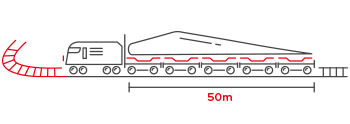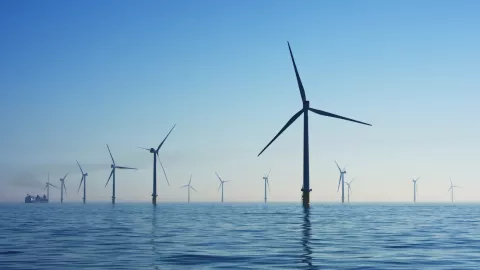In California, between the breeze of the Pacific Ocean and the heat of the Mojave Desert, lies Tehachapi Canyon, an excellent area for harnessing wind energy.
This the location with the lowest altitude between the fresh ocean air and the desert heat. And wind - which forms due to temperature differences and the pressure of gases in our atmosphere - always searches for lower areas. Thus, every day, as the sun begins to fade and the clash between these temperature and humidity differences occurs, wind floods the canyon like a river.
This intense yet predictable single-direction wind current made Tehachapi Canyon one of the first locations chosen for the implementation of wind turbines in the US. Over the years, with the evolution of wind power technology, the canyon was taken over by turbines from different eras, becoming like a museum.
Turbines with different formats, capacities and technical specifications dot the landscape in several areas of the canyon, testifying to the passage of time and the enormous growth this energy generation method has had.
A museum that creates light
Rising Tree, EDP Renováveis' wind farm in Tehachapi Canyon, boasts an installed capacity of 198 megawatts (MW) - enough to provide electricity to about 92,000 homes in California. Featuring some of the most advanced turbines available at the time, the wind farm started operating in 2014.
But just a few kilometers away from these and other state-of-the-art aerogenerators, there are several wind turbines dating back to the 1980s and the 1990s still in operation - 10 times smaller than the current ones, and a thousand times less powerful. Just to give you an idea, six modern wind turbines produce the same amount of energy as 240 turbines did 20 years ago.
But how is it possible to keep 40-year-old turbines in operation today? One of the strategies was to reuse damaged turbine parts, incorporating them into those that are still working. It may seem insignificant, but it is not: replacement parts for 40-year-old turbines have been simply discontinued. Thus, by removing parts from some turbines and repairing others, it became possible to keep 80 to 90 old turbines working - in a place that hosted 240 aerogenerators 20 years ago.
First steps, trial and error
A visit to this region reveals a somewhat chaotic distribution of wind turbines. State-of-the-art models share the space, functions and responsibility with their predecessors as if they were employees of various ages working in the same company.
This heterogeneous landscape, in which clusters of gigantic turbines alternate with smaller, less powerful ones, is also due to technological evolution.
In the 1970s and 1980s there were no tools to effectively measure wind speed (the so-called anemometers) nor satellites circling the atmosphere, so it was not possible to obtain an overview of the country or determine the most productive wind regions available. Moreover, today's turbines can operate at variable speeds, while in the past only very strong winds could be harnessed.
As such, experts were not entirely sure of the optimal location for their wind turbines; it was a trial-and-error approach, resulting in the seemingly chaotic distribution of older aerogenerators.
An expanding technology
No energy source can boast the qualitative and quantitative leap of wind power in such a short span of time: in just two decades, it reached 370GW of cumulative production worldwide.
Most of the installed capacity is located in Asia, followed by Europe and the US, but emerging economies play a bigger role every year.
And as installed capacity grew, technology also evolved, producing more energy at a lower cost, but also in a more efficient and sustainable manner. In other words, technological evolution does not merely seek to produce more energy; concerns such as minimizing environmental impacts or improving integration with power grids also play a significant role.
Technological advances have even made it possible to exploit this renewable energy source in places with reduced wind power potential, such as colder climates or higher altitudes, where air density is lower.
Turbines for all tastes
Turbine manufacturers are constantly looking to tailor their solutions to each project's specific challenges. The proliferation of manufacturers has been stimulating the market, and available technologies change from place to place. The competition is such that you can go to specialized websites and read lists of 'The 10 Best Wind Turbines of the Year', as if you were buying a smartphone or something like that.
But which criteria distinguish one wind turbine from another? What would you have to know if you wanted to deploy a wind turbine? A normal wind turbine usually comprises the following elements:
- A steel, cement or hybrid base.
- A three-bladed rotor with an active orientation mechanism to maintain wind direction alignment.
- A high-speed wind control system (pitch control).
- A variable-speed drive unit, making it possible to optimize energy collection even with weak winds.
The base
When we look at wind turbine bases available in the market, we can see that manufacturers tend to build them higher and higher as the size of turbine rotors increases.
However, the costs of building a tower and its base increase proportionally, so operators must always consider each solution's cost-benefit ratio.
Steel towers have been the most widely adopted solution, but higher towers have forced manufacturers to look for other alternatives. This is because building a very tall steel tower requires a base with a considerably larger diameter: for instance, a 100-meter-high tower requires a four-meter-diameter base! This makes their transport particularly difficult, turning on-site construction into a viable alternative.
Other solutions include a mixture of steel and concrete in which the base is made of concrete (reinforced on site or brought in parts) and the top of the tower consists of tubular steel structures.


The rotor
Rotors (turbine blades) have become larger and larger over time, but the most important aspect is that the blades' sweeping area, i.e. is the amount of wind energy they can capture, has doubled.
It should also be noted that the diameter of turbine rotors varies greatly depending on their location - or, more specifically, on each region's wind profile. Rotors in the US are usually larger than in other markets, as the country's winds are typically medium speed.
The diameter of rotors in Europe varies even more than in Asia or the US - the characteristics of European winds are very different from country to country, which justifies this diversity.
We can see that increasing the size of the blades increases energy capture, but we should keep in mind that the larger the blades on a rotor, the harder it is to transport. Just imagine the turning radius required to make a turn while carrying paddles measuring over 50 meters...


Control systems
Wind turbines, also known as aerogenerators, are built to withstand very strong winds, but only when they are not working. That is, they can withstand a storm, but only if the blades are not moving - if they were allowed to rotate freely under the harshest winds, they would generate such power that they would eventually destroy the turbine.
Therefore, today's wind turbines are equipped with control systems and brakes that come into operation when winds reach certain speeds, preventing accidents. There are two main types of such systems: stall control and pitch control.
In the 1980s the market focused on a Danish three-bladed turbine model with passive control technology (the so-called stall method), allowing for an average 200kW capture. But technology has evolved since then, and the standard option today is variable speed turbines with pitch control systems.
Pitch control is simply the ability to change the angle of turbine blades, that is, to rotate them on their own axis so that they do not face excessively strong winds head-on.
Turbine size has also been increasing steadily. The capacity of the most commonly used (onshore, not offshore) wind turbines ranges between 1.5 and 3 MW, with heights ranging from 90 to 110 meters and blades with a diameter as large as 120 meters! It is not surprising that special care is taken to prevent them from falling apart and rolling off the ground.


The drive unit
The drive unit converts the kinetic energy captured by the rotor into electrical energy. And we can classify turbines according to the steps this conversion entails:
- Motorized turbine with a dual-feed generator: The drive unit converts the low speed at which the blades rotate into the much higher speed required for the generator to operate. This generator's speed can be adjusted to the kinetic system's speed.
- Direct drive turbine: These turbines have a generator directly coupled to the main shaft, with magnets that rotate at the same speed as the rotor, thus producing electricity. This generator is connected to the grid using a power converter that adjusts the voltage of the electricity it generates to that of the grid.
- Mixed/hybrid turbine: The bigger the blades on a turbine, the slower they spin. On the other hand, the magnets on the generators must spin at a very high speed in order to produce electricity. This usually requires complex and heavy equipment to convert kinetic energy into electrical energy. Hybrid turbines are a simplified solution that uses a gearbox to convert the low speed of the blades into the medium or high speed of the generators.
Illustration - the inside of a turbine:


As we have seen, today's wind turbines are sophisticated machines designed to harness the kinetic energy of wind and convert it into electricity. The blades catch the wind and rotate an internal shaft, which is connected to a gearbox. The latter then rotates a generator that produces electricity.
The towers, made of steel or concrete, support a three-bladed rotor and include a cubicle where the inner shaft, gearbox, generator and control system are located.
Wind force is measured on a regular basis to determine the best position of the turbine (so as to make it face the strongest winds) and its blades (to optimize capture while avoiding accidents).
Going to the museum to see the wind
Wind power technology is constantly changing to create more sturdy machines yet with less environmental and visual impact. Improving turbine efficiency remains a challenge due to the exponential growth in the weight and size of turbine components.
The various sizes and shapes of the turbines manufactured so far are on display - and in operation - in the Rising Tree region. This museum, which is actually a wind farm, tells an interesting part of the history of energy. It is well worth a visit if you go to California.
California's Rising Tree wind farm is operated by EDP Renewables (EDPR) North America and is the fourth-largest wind farm in terms of installed capacity in the US. Besides this, EDPR operates wind farms in 14 US states, as well as in Canada and Mexico.

